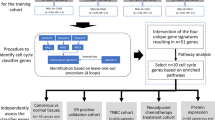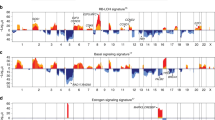Abstract
The introduction of DNA microarray techniques has had dramatic implications on cancer research, allowing researchers to analyze expression of multiple genes in concert and relate the findings to clinical parameters. The main discoveries in breast cancer, as well as in other malignancies, have so far been with respect to two key issues. First, individual tumors arising from the same organ may be grouped into distinct classes based on their gene expression profiles, independent of stage and grade. Second, the biologic relevance of such classification is corroborated by significant prognostic impact. We review how the use of microarray technologies can provide unique possibilities to explore the mechanisms of tumor behavior in vivo that will allow evaluation of prognosis and, potentially, drug resistance. However, in spite of recent advances, we are not yet at a stage where the use of these techniques should be implemented for routine clinical use, whether to define prognostic factors or to predict sensitivity to therapy.
This is a preview of subscription content, access via your institution
Access options
Subscribe to this journal
Receive 12 print issues and online access
$209.00 per year
only $17.42 per issue
Buy this article
- Purchase on Springer Link
- Instant access to full article PDF
Prices may be subject to local taxes which are calculated during checkout




Similar content being viewed by others
References
Levi F et al. (2001) The fall in breast cancer mortality in Europe. Eur J Cancer 37: 1409–1412
Abe O et al. (1998) Polychemotherapy for early breast cancer: an overview of the randomised trials. Lancet 352: 930–942
Early Breast Cancer Trialist Group (1998) Tamoxifen for early breast cancer: An overview of the randomised trials. Lancet 351: 1451–1467
Citron ML et al. (2003) Randomized trial of dose-dense versus conventionally scheduled and sequential versus concurrent combination chemotherapy as postoperative adjuvant treatment of node-positive primary breast cancer: first report of Intergroup Trial C9741/Cancer and Leukemia Group B Trial 9741. J Clin Oncol 21: 1431–1439
Lønning PE (2003) Study of suboptimum treatment response: lessons from breast cancer. Lancet Oncol 4: 177–185
Muss HB et al. (1994) c-erbB-2 expression and response to adjuvant therapy in women with node-positive early Breast cancer. N Engl J Med 330: 1260–1266
Aas T et al. (1996) Specific P53 mutations are associated with de novo resistance to doxorubicin in breast cancer patients. Nat Med 2: 811–814
Holloway AJ et al. (2002) Options available–from start to finish–for obtaining data from DNA microarrays. Nat Genet 32: 481–489
Quackenbush J (2001) Computational analysis of microarray data. Nat Rev Genet 2: 418–427
Ball CA et al. (2002) Standards for Microarray data. Science 298: 539–539
Perou CM et al. (2000) Molecular portraits of human breast tumours. Nature 406: 747–752
Sorlie T et al. (2001) Gene expression patterns of breast carcinomas distinguish tumor subclasses with clinical implications. Proc Natl Acad Sci U S A 98: 10869–10874
Sorlie T et al. (2003) Repeated observation of breast tumor subtypes in independent gene expression data sets. Proc Natl Acad Sci U S A 100: 8418–8423
Sotiriou C et al. (2003) Breast cancer classification and prognosis based on gene expression profiles from a population-based study. Proc Natl Acad Sci U S A 100: 10393–10398
Zhao HJ et al. (2004) Different gene expression patterns in invasive lobular and ductal carcinomas of the breast. Mol Biol Cell 15: 2523–2536
Geisler S et al. (2001) Influence of TP53 gene alterations and c-erbB-2 expression on the response to treatment with doxorubicin in locally advanced breast cancer. Cancer Res 61: 2505–2512
van't Veer LJ et al. (2002) Gene expression profiling predicts clinical outcome of breast cancer. Nature 415: 530–536
Ma XJ et al. (2004) A two-gene expression ratio predicts clinical outcome in breast cancer patients treated with tamoxifen. Cancer Cell 5: 607–616
Beer D et al. (2002) Gene-expression profiles predict survival of patients with lung adenocarcinoma. Nat Med 8: 816–824
Glinsky GV et al. (2004). Gene expression profiling predicts clinical outcome of prostate cancer. J Clin Invest 113: 913–923
Pomeroy SL et al. (2002) Prediction of central nervous system embryonal tumour outcome based on gene expression. Nature 415: 436–442
Chung CH et al. (2004) Molecular classification of head and neck squamous cell carcinomas using patterns of gene expression. Cancer Cell 5: 489–500
Shipp MA et al. (2002) Diffuse large B-cell lymphoma outcome prediction by gene-expression profiling and supervised machine learning. Nat Med 8: 68–74
Nakamura T et al. (2004) Genome-wide cDNA microarray analysis of gene expression profiles in pancreatic cancers using populations of tumor cells and normal ductal epithelial cells selected for purity by laser microdissection. Oncogene 23: 2385–2400
Weiss MM et al. (2003) Genomic profiling of gastric cancer predicts lymph node status and survival. Oncogene 22: 1872–1879
Bertucci F et al. (2004) Gene expression profiling of colon cancer by DNA microarrays and correlation with histoclinical parameters. Oncogene 23: 1377–1391
Yeoh E et al. (2002) Classification, subtype discovery, and prediction of outcome in pediatric acute lymphoblastic leukemia by gene expression profiling. Cancer Cell 1: 133–143
Rosenwald A et al. (2003) Molecular diagnosis of primary mediastinal B cell lymphoma identifies a clinically favorable subgroup of diffuse large B cell lymphoma related to Hodgkin lymphoma. J Exp Med 198: 851–862
van de Vijver MJ et al. (2002) A gene-expression signature as a predictor of survival in breast cancer. N Engl J Med 347: 1999–2009
Ahr A et al. (2002) Identification of high risk breast-cancer patients by gene expression profiling. Lancet 359: 131–132
Onda M et al. (2004) Gene expression patterns as marker for 5-year postoperative prognosis of primary breast cancer. J Cancer Res Clin Oncol 130: 537–545
Huang E et al. (2003) Gene expression predictors of breast cancer outcomes. Lancet 361: 1590–1596
Nagahata T et al. (2004) Expression profiling to predict postoperative prognosis for estrogen receptor-negative breast cancers by analysis of 25,344 genes on a cDNA microarray. Cancer Sci 95: 218–225
Huang E et al. (2003) Gene expression profiling for prediction of clinical characteristics of breast cancer. Recent Prog Horm Res 58: 55–73
Pittman J et al. (2004) Integrated modeling of clinical and gene expression information for personalized prediction of disease outcomes. Proc Natl Acad Sci U S A 101: 8431–8436
Eden P et al. (2004) “Good Old” clinical markers have similar power in breast cancer prognosis as microarray gene expression profilers. Eur J Cancer 40: 1837–1841
Ein-Dor L et al. (2004) Outcome signature genes in breast cancer: is there a unique set? Bioinformatics [doi: 10.1093/bioinformatics/bth469]
Chang J et al. (2003) Gene expression profiling for the prediction of therapeutic response to docetaxel in patients with breast cancer. Lancet 362: 362–369
Ayers M et al. (2004) Gene expression profiles predict complete pathologic response to neoadjuvant paclitaxel and fluorouracil, doxorubicin, and cyclophosphamide chemotherapy in breast cancer. J Clin Oncol 22: 2284–2293
Brenton JD and Caldas C (2003) Predictive cancer genomics–what do we need? Lancet 362: 340–341
Ellis M and Ballman K (2004) Trawling for genes that predict response to breast cancer adjuvant therapy. J Clin Oncol 22: 2267–2269
Therasse P et al. (2000) New guidelines to evaluate the response to treatment in solid tumors. J Natl Cancer Inst 92: 205–216
Kannan K et al. (2001) DNA microarrays identification of primary and secondary target genes regulated by p53. Oncogene 20: 2225–2234
Yoon H et al. (2002) Gene expression profiling of isogenic cells with different TP53 gene dosage reveals numerous genes that are affected by TP53 dosage and identifies CSPG2 as a direct target of p53. Proc Natl Acad Sci U S A 99: 15632–15637
Muller A et al. (2001) Involvement of chemokine receptors in breast cancer metastasis. Nature 410: 50
Vousden KH and Lu X (2002) Live or let die: The cell's response to p53. Nat Rev Cancer 2: 594–604
Lønning PE (2004) Genes causing inherited cancer as beacons identifying the mechanisms of chemoresistance. Trends Mol Med 10: 113–118
Author information
Authors and Affiliations
Corresponding author
Rights and permissions
About this article
Cite this article
Lønning, P., Sørlie, T. & Børresen-Dale, AL. Genomics in breast cancer—therapeutic implications. Nat Rev Clin Oncol 2, 26–33 (2005). https://doi.org/10.1038/ncponc0072
Received:
Accepted:
Issue Date:
DOI: https://doi.org/10.1038/ncponc0072
This article is cited by
-
Effect of sample size on prognostic genes analysis in non-small cell lung cancer
Molecular Genetics and Genomics (2023)
-
Feature selection and computational optimization in high-dimensional microarray cancer datasets via InfoGain-modified bat algorithm
Multimedia Tools and Applications (2022)
-
Gene selection for cancer classification with the help of bees
BMC Medical Genomics (2016)
-
Tailored targeted therapy for all: a realistic and worthwhile objective?
Breast Cancer Research (2009)
-
Prediction of breast cancer metastasis by genomic profiling: where do we stand?
Clinical & Experimental Metastasis (2009)



